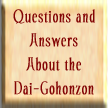
| Q: | What has Shakyamuni statue-worship to do with the subject of the Dai-Gohonzon? |
| A: | Statue-worship in Buddhism was practiced before Nichiren Daishonin inscribed the Gohonzon. To follow Nichiren is to acknowledge his declaration that “this Gohonzon shall be called the great mandala never known before” (Writings of Nichiren Daishonin, p. 832). The doctrine of Dai-Gohonzon as a Gohonzon for all humanity is directly opposed to the basic beliefs of many people, whose object of veneration is Shakyamuni's statue, or a combination of mandalas and statue. For this reason, the real problem in the dispute is not about the Dai-Gohonzon, but it is about these questions: What is the Object of Veneration in Buddhism? Is it the mandala or the statue? |
For example, Nichiren Shu holds that the object of worship can be any of the five following objects :
- Shakyamuni statue
- Mandala Honzon (a Gohonzon)
- the Daimoku (written on a stupa or banner)
- Shakyamuni statue together with statues of the four Bodhisattvas together with Nichiren’s statue (as established in the Honden, Main Sanctuary)
- Daimoku stupa with Taho statue and Shakyamuni statue
From this source, it is obvious that statue-worship of Shakyamuni Buddha is relevant to Nichiren Shu beliefs. This is in direct conflict with the doctrine of Gohonzon as the only Object of Veneration, and it is not difficult to understand the reason behind the opposition against the doctrine of Gohonzon for all humanity, or Dai-Gohonzon.
Another group which opposes the doctrine of Dai-Gohonzon is Rissho Koseikei. In its book “Honzon” written by Nikkyo Niwano, 1969, the Object of Worship is defined as the statue of Shakyamuni Eternal Buddha (almost in identical terms with Nichiren Shu). It is only natural that the Dai-Gohonzon would be perceived as a threat — or at least, a competition — to Rissho Koseikei's arbitrarily established Object of Veneration (which is a statue — a standing figure of Shakyamuni). But strangely enough, the Rissho Koseikei group deviates from its statue worship to additionally allow for Mandalas to be enshrined in its members' homes for worship instead of Shakyamuni’s statues. Having two forms of Object of Worship (a Statue in temples and a Mandala in members' homes) is a contradiction in itself, and this is admitted by the founder in his book Honzon: “This looks like a contradiction, but we should not overlook the mystery in the Buddha’s intention which is beyond the understanding of ordinary men." (page 32 of Honzon, describing the Object of Worship of Rissho Koseikei, as a standing figure of Shakyamuni).
A further example of a Buddhist school which is strongly opposed to the doctrine of the Dai-Gohonzon is the Kempon Hokke Shu (KHS). Similarly to the other schools like Nichiren Shu, the KHS regards Shakyamuni as the Object of Worship. According to "The Object of Worship of the Doctrine of the Original" taken from the Analects of the Kempon Hokke-Jumonryu) the following Objects are termed “permissible”:
- A mandala,
- A written scroll with the Daimoku,
- Images of Shakyamuni and Taho Buddhas,
- Images of Shakyamuni and the Four Bodhisattvas,
- A statue of Shakyamuni with a copy of the Lotus Sutra placed before it.
It is evident that a Gohonzon for
all people, priests and laity, or a Dai-Gohonzon for all humanity, is a
doctrine which upsets the arbitrarily established views of various Nichiren
schools.
This work has been compiled by individual SGI members and is solely our personal opinion, based on years of practice and study.